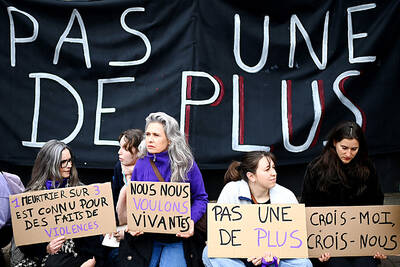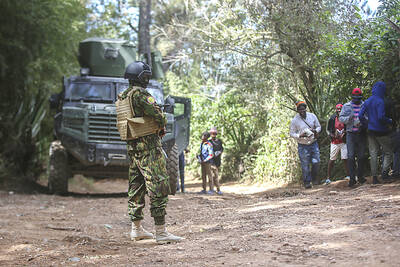Handmade in jail, the Chinese characters on Hong Kong’s old road signs have a distinct style that a group of enthusiasts has painstakingly documented and turned into a new digital font called Prison Gothic.
Their leader, Gary Yau, said he became interested in them when he was a boy, even learning to write some characters by copying them from road signs.
As signs made with computer-generated text began to replace the old ones, Yau began a personal quest in 2016 to record the handmade characters, imperfections and all.

Photo: AFP
“I want to preserve this local, visual culture,” 24-year-old Yau said. “The search and collection have been like a race against the authorities, because we do not know when they will retire an old sign.”
Before digital design and production were introduced, the characters and symbols on Hong Kong’s road signs were hand-drawn, carved out and assembled by inmates in the territory’s prisons.
Without the precision of computers and machine-cutting, these signs were not uniform, with varying characters and line thickness.

Photo: AFP
Over the past six years, Yau and his team of six — the Road Research Society — have scoured the streets of Hong Kong to find 500 of these older signs, produced by prisoners from the 1970s to the 1990s.
The 600 Chinese characters they collected from these signs became the base from which they developed a digital typeface of about 8,000 commonly used characters.
This month, the Road Research Society — which Yau founded in his freshman year at university — launched a crowdfunding initiative to secure HK$700,000 (US$89,177) for the last leg of the project.
The medium version of the font is to be released in November this year.
The irony that road signs for travelers are made by people in jail is not lost on Yau, who said he was impressed by their skill.
David Tsang, a broadcast engineer in the US, was one of the first to leave a supportive comment on Yau’s crowdfunding page.
“It feels like carrying an old soul ... reminding me of the old Hong Kong,” Tsang said. “I want to preserve some Hong Kong culture and personality as a Hong Konger overseas.”
The link between a font and identity is not unique to Prison Gothic.
At least half a dozen Hong Kong-inspired fonts have been invented or revamped since 2016, a period when two major pro-democracy movements sparked interest in localism — promoting the concept of the territory’s unique identity.
Hong Kong, like Taiwan, uses traditional Chinese characters, as opposed to the simplified ones used in China.
Some of the Hong Kong designs borrow from calligraphy styles that were once widely seen on shop signs, and on wooden or stone tablets on traditional village gates.
At least two — the Kick Ass Type and the Rebirth Font — were inspired by the 2014 Umbrella movement and the huge pro-democracy protests in 2019 respectively.
Prison Gothic itself has taken on a different resonance in the last few years, as Beijing has imposed a political crackdown on Hong Kong that has seen thousands arrested for taking part in the protests three years ago.
“Responding to the social movements and changes is a big incentive for the fonts’ development,” said Brian Kwok (郭斯恒), associate professor at Hong Kong Polytechnic University’s School of Design.
“In the past, symbols of Hong Kong local culture might be egg tarts, milk tea and the Lion Rock,” Kwok said. “Now fonts have become a way for young people to explore their Hong Kong identity.”

A French-Algerian man went on trial in France on Monday for burning to death his wife in 2021, a case that shocked the public and sparked heavy criticism of police for failing to take adequate measures to protect her. Mounir Boutaa, now 48, stalked his Algerian-born wife Chahinez Daoud following their separation, and even bought a van he parked outside her house near Bordeaux in southwestern France, which he used to watch her without being detected. On May 4, 2021, he attacked her in the street, shot her in both legs, poured gasoline on her and set her on fire. A neighbor hearing

DEATH CONSTANTLY LOOMING: Decades of detention took a major toll on Iwao Hakamada’s mental health, his lawyers describing him as ‘living in a world of fantasy’ A Japanese man wrongly convicted of murder who was the world’s longest-serving death row inmate has been awarded US$1.44 million in compensation, an official said yesterday. The payout represents ¥12,500 (US$83) for each day of the more than four decades that Iwao Hakamada spent in detention, most of it on death row when each day could have been his last. It is a record for compensation of this kind, Japanese media said. The former boxer, now 89, was exonerated last year of a 1966 quadruple murder after a tireless campaign by his sister and others. The case sparked scrutiny of the justice system in

DITCH TACTICS: Kenyan officers were on their way to rescue Haitian police stuck in a ditch suspected to have been deliberately dug by Haitian gang members A Kenyan policeman deployed in Haiti has gone missing after violent gangs attacked a group of officers on a rescue mission, a UN-backed multinational security mission said in a statement yesterday. The Kenyan officers on Tuesday were on their way to rescue Haitian police stuck in a ditch “suspected to have been deliberately dug by gangs,” the statement said, adding that “specialized teams have been deployed” to search for the missing officer. Local media outlets in Haiti reported that the officer had been killed and videos of a lifeless man clothed in Kenyan uniform were shared on social media. Gang violence has left

‘HUMAN NEGLIGENCE’: The fire is believed to have been caused by someone who was visiting an ancestral grave and accidentally started the blaze, the acting president said Deadly wildfires in South Korea worsened overnight, officials said yesterday, as dry, windy weather hampered efforts to contain one of the nation’s worst-ever fire outbreaks. More than a dozen different blazes broke out over the weekend, with Acting South Korean Interior and Safety Minister Ko Ki-dong reporting thousands of hectares burned and four people killed. “The wildfires have so far affected about 14,694 hectares, with damage continuing to grow,” Ko said. The extent of damage would make the fires collectively the third-largest in South Korea’s history. The largest was an April 2000 blaze that scorched 23,913 hectares across the east coast. More than 3,000